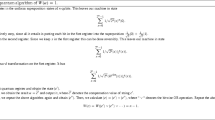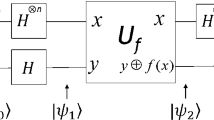Abstract
Quantum algorithms for the analysis of Boolean functions have received a lot of attention over the last few years. The algebraic normal form (ANF) of a linear Boolean function can be recovered by using the Bernstein–Vazirani (BV) algorithm. No research has been carried out on quantum algorithms for learning the ANF of general Boolean functions. In this paper, quantum algorithms for learning the ANF of quadratic Boolean functions are studied. We draw a conclusion about the influences of variables on quadratic functions, so that the BV algorithm can be run on them. We study the functions obtained by inversion and zero-setting of some variables in the quadratic function and show the construction of their quantum oracle. We introduce the concept of “club” to group variables that appear in quadratic terms and study the properties of clubs. Furthermore, we propose a bunch of algorithms for learning the full ANF of quadratic Boolean functions. The most efficient algorithm, among those we propose, provides an O(n) speedup over the classical one, and the number of queries is independent of the degenerate variables.



Similar content being viewed by others
References
Arute, F., Arya, K., Babbush, R., Bacon, D., Bardin, J.C., Barends, R., et al.: Quantum supremacy using a programmable superconducting processor. Nature 574(7779), 505–510 (2019)
Shor, P.W.: Polynomial-time algorithms for prime factorization and discrete logarithms on a quantum computer. SIAM Rev. 41(2), 303–332 (1999)
Grover, L.K.: A fast quantum mechanical algorithm for database search. In: Proceedings of the 28th Annual ACM Symposium on Theory of Computing, pp. 212–219 (1996)
Simon, D.R.: On the power of quantum computation. SIAM J. Comput. 26(5), 1474–1483 (1997)
Bernstein, E., Vazirani, U.: Quantum complexity theory. SIAM J. Comput. 26(5), 1411–1473 (1993)
Matsui, M.: Linear cryptanalysis method for DES Cipher. EUROCRYPT 1993, 386–397 (1994)
Millan, W.: Low order approximation of cipher functions. CPA 1995, 144–155 (1995)
Wang, Q., Tan, C.H.: On the second-order nonlinearity of the hidden weighted bit function. Discrete Appli. Math. 215, 197–202 (2016)
Shi, D., Sun, S., Sasaki, Y., Li, C., Hu, L.: Correlation of quadratic Boolean functions: cryptanalysis of all versions of full \(\sf MORUS\). CRYPTO 2019, 180–209 (2019)
Dillon, J.F.: Elementary Hadamard difference sets. (Doctoral dissertation) (1974)
McFarland, R.L.: A family of difference sets in non-cyclic groups. J. Comb. Theory Ser. A. 15(1), 1–10 (1973)
Camion, P., Carlet, C., Charpin, P., Sendrier, N.: On correlation-immune functions. In: CRYPTO 1991, 86–100 (1991)
Floess, D., Andersson, E., Hillery, M.: Quantum algorithms for testing and learning Boolean functions. Math. Struct. Comput. Sci. 23(2), 386–398 (2013)
Li, H., Yang, L.: A quantum algorithm for approximating the influences of Boolean functions and its applications. Quantum Inf. Process. 14(6), 1787–1797 (2015)
Li, H., Yang, L.: A quantum algorithm to approximate the linear structures of Boolean functions. Math. Struct. Comput. Sci. 28(1), 1–13 (2018)
Xie, H., Yang, L.: Using Bernstein–Vazirani algorithm to attack block ciphers. Des. Codes Crypt. 87(5), 1161–1182 (2019)
Zhang, F., Hao, X., Wei, Y., Zhou, Y.: Quantum period finding based on the Bernstein–Vazirani algorithm. Quantum Inf. Comput. 20(1&2), 65–84 (2020)
Li, H.: A quantum algorithm for testing and learning resiliency of a Boolean function. Quantum Inf. Process. 18, 51 (2019)
Chakraborty, K., Chattopadhyay, A., Maitra, S.: Quantum algorithms to check resiliency, symmetry and linearity of a Boolean function. https://eprint.iacr.org/2013/232.pdf (2013). Accessed 26 Nov (2019)
Chakraborty, K., Maitra, S.: Improved quantum test for linearity of a Boolean function. arXiv:1306.6195 (2013). Accessed 26 Nov (2019)
Acknowledgements
X. Hao and F. Zhang were supported in part by the National Natural Science Foundation of China (No. 61972400), the Natural Science Foundation of Jiangsu Province (No. BK20181352) and the Guangxi Key Laboratory of Cryptography and Information Security (No. GCIS201712).
Author information
Authors and Affiliations
Corresponding author
Additional information
Publisher's Note
Springer Nature remains neutral with regard to jurisdictional claims in published maps and institutional affiliations.
Rights and permissions
About this article
Cite this article
Hao, X., Zhang, F., Xia, S. et al. Quantum algorithms for learning the algebraic normal form of quadratic Boolean functions. Quantum Inf Process 19, 273 (2020). https://doi.org/10.1007/s11128-020-02778-3
Received:
Accepted:
Published:
DOI: https://doi.org/10.1007/s11128-020-02778-3




